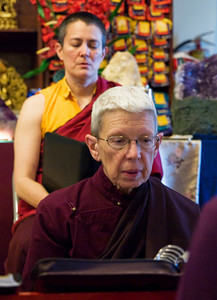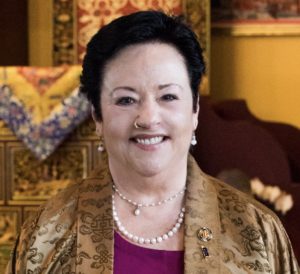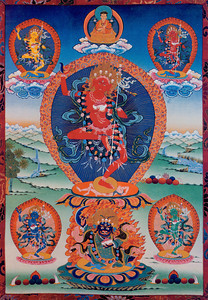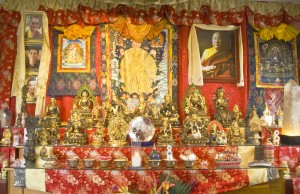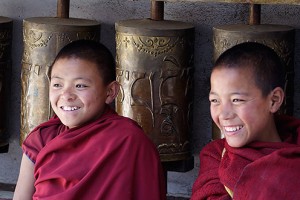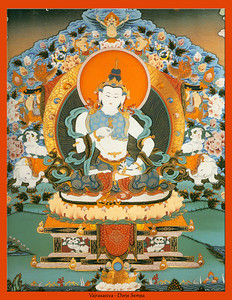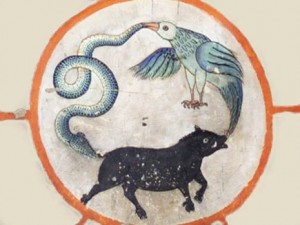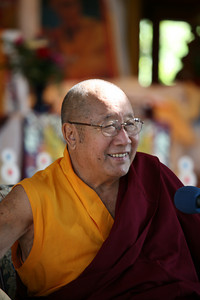An excerpt from Marrying Spiritual Life with Western Culture by Jetsunma Ahkon Lhamo
If you have a real relationship with your own nature and you really understood the wisdom and the beauty of the Buddha’s teaching and didn’t see it as his teaching, but as a wisdom that appeared in the world here. You could see it as your teaching, as a wisdom that you could connect with.
Actually, we Westerners have a similar problem to what Black Americans have approaching Christianity. Black Americans pray to white Jesus. It’s not to say that their faith is small. I don’t know whether they have a problem with it or not, but it must be odd. What does it look like seeing a white face on an altar when you’re a black person? Go home and look at all those Asian faces on your altar? They don’ t look like us. What to do about it? How do you take refuge? How do you connect? It’s not about those pictures. It’s not about those faces. It’s about you! And it connects inside.
It isn’t about the shape of those eyes. It’s about what those eyes see. So you have to have that completely personal relationship where you look beyond that which is slanted or colored or this way or that way. It’s got to be a deeply personal relationship. To do that you must connect deeper than you’ve ever been before. We love to just skate over the surface of our experience of life. We’re even addicted to the highs and lows.
You can’t really understand why and how to take refuge by learning a set of equations or laws or rules. These can only function as guidelines. It’s really up to us to be powerful and strong and noble and knowing and awake on our path. Virtue cannot be collected. It has to be experienced, tasted, understood. Its nature must be understood.
This is not the news we want to hear. We want an easy religion. We think, “Just tell us the ten things we have to do so that we’re not uncomfortable about dying.” I’m not saying those ten things are bad they’re good, they’re wonderful, but where does it lead you? Aren’t you still the same scared little kid who was so neurotic because you are compressed with rules and society and with being told you can’t feel things? And now we’re going to do this with our religion too. Ten more times.
What if, instead of being a girdle that makes us out of touch just trying so hard to be good, we experienced our path – our method – in a wisdom way, in a connected way, in an in-touch way? From that fertilization that happens when you really understand an idea and it causes you to go, “Ah, hah, therefore…” from that point of view it’s like a plant or a tree coming up inside you and growing. It bears fruit. It is a joyful thing, and you can see the fruit of your life. Most of us are so unhappy and so neurotic because we cannot see the fruit of our life and we do not understand its value. We have not tasted it. This direct relationship one can taste.
It needs to be like that in order for us to really take refuge and not be lost, little kids scared of dying, just trying to do the right thing be good boys and good girls with a new set of rules – because maybe if we just had a new set of rules, maybe then we’d be good.
Instead of that, what if we were dynamically in love, inspired, breathing in and out on our path? The path can, in that way, be a companion, a joyfulness, a child of yours, a creation, a painting, something beautiful you’ve done with your life. You can’t make a beautiful painting by number. You have to make a beautiful painting from your heart.
So ask yourself, where are you? If you find that deadness inside of you, don’t blame your path, don’t blame your teacher, don’t blame your society, and don’t blame the Buddha. Instead, go within and find what is true and meaningful to you. Work the sums. Reason it out. Lord Buddha himself said, “Forget blind faith.” He said, “Reason it out.” The path should make sense. It should be logical and meaningful to you, not to me. What’s it going to mean to you if it’s meaningful to me? It has to be logical and meaningful to you. This is what the Buddha said. It would really help you to try that out for yourself, living in a society where we are separate from some fundamental life rhythms and where we are trained to think that things are happening outside of us.
We’re in a world filled with terrorism and racial abuse, religious abuse, all kinds of conflict, and yet we think racial intolerance for instance, is happening out there. We read about it in the paper. No, racial intolerance is happening in here. That’s where it’s happening.
It’s like that with everything on this path. You cannot let it happen out there. It’s your responsibility, your empowerment, your life. Waiting for someone to tell you how to live it is not going to fly. When you walk on a spiritual path that you know, that you have examined, that you have given rise to understanding, you draw forth your natural innate wisdom. That fills your heart with a sense of truth because you understand it – not because someone else does. That’s the way to do it, and that’s what the Buddha recommended. In fact, he said, “I’ve given you the path. Now work out your own salvation.”
That wasn’t just a flip thing. When people hear that they go, “It’s such a cool thing that he said that! He must have had a great sense of humor.” He meant it! The path is there, but you’ve got to work it out. That’s how you walk on the path. Otherwise you’re walking alongside the path. Then you’re a friend of Dharma, an admirer of Dharma, but not a practitioner – even if you wear the robes.
So handle the dead zone. Empower yourself. There is no reason why you can’t. Don’t live your life by “bash-to-fit, paint-to-match.” Don’t do that. You are alive. In every sense, your nature is the most vibrant force in the universe, the only force in the universe. It is all there is. To play this game of duality where you stand outside your own most intimate experience and like a sheep get led through your life, that is not the way to go.
Many of you came to this path from another path because you felt dead there. But remember this: Wherever you go, there you are. You brought the deadness with you. So handle it.
I hope that you really, really take this teaching to heart because it’s really an important thing. If I had one gift that I could give you all, it would be to stay alive in your path, to have your spiritual life be like a precious jewel inside of you, living, something to warm you by. If life took everything else away from you, which it will eventually, this is the thing that cannot be taken. Thank you very much.
Copyright © 1996 Jetsunma Ahkon Lhamo. All rights reserved
